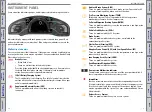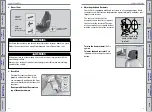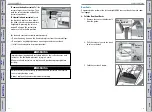
18 |
| 19
SAFETY
SAFETY
9. Impact sensors that can detect a moderate-to-severe front or side
impact.
10. An indicator on the dashboard that alerts you that the front passenger’s
front airbag has been turned off.
11. An indicator on the instrument panel that alerts you to a possible
problem with your airbag system or seat belt tensioners.
12. A rollover sensor that can detect if your vehicle is about to roll over and
signal the control unit to deploy both side curtain airbags.
n
Airbag Care
You do not need to, and should not, perform any maintenance on or replace
any airbag system components yourself. However, you should have your
vehicle inspected by a Clarity Electric in the following situations:
When the airbags have deployed
If an airbag has inflated, the control unit and other related parts must
be replaced. Similarly, once an automatic seat belt tensioner has been
activated, it must be replaced.
When the vehicle has been in a moderate-to-severe collision
Even if the airbags did not inflate, have your authorized Honda Clarity
Electric dealer inspect the following: the driver’s seat position sensor,
weight sensors in the passenger’s seat, front seat belt tensioners, and each
seat belt that was worn during the crash.
Do not remove or modify a front seat without first consulting a dealer
This would likely disable the driver’s seat position sensor or the weight
sensors in the passenger’s seat. If it is necessary to remove or modify a
front seat to accommodate a person with disabilities, contact a Honda
Clarity Electric dealer or call Honda Automobile Customer Service at (800)
999-1009.
Child Safety
Each year, many children are injured or killed in vehicle crashes because they
are either unrestrained or not properly restrained. In fact, vehicle collisions are
the number-one cause of death of children ages 12 and under.
The National Highway Traffic Safety Administration recommends that all
children ages 12 and under be properly restrained in a rear seat. Some states
have laws restricting where children may ride.
To reduce the number of child deaths and injuries, every state requires that
infants and children be properly restrained when they ride in a vehicle.
n
Protecting Child Passengers
• An inflating front or side airbag can injure or kill a child sitting in the front
seat.
• A child in the front seat is more likely to interfere with the driver’s ability to
safely control the vehicle.
• Statistics show that children of all sizes and ages are safer when they are
properly restrained in a rear seat.
• Any child who is too small to wear a seat belt correctly must be restrained
in an approved child seat that is properly secured to the vehicle using
either the lap belt portion of the lap/shoulder belt or the lower anchors of
the LATCH system.
• Never put a seat belt over yourself and a child. During a crash, the belt
would likely press deep into the child and cause serious or fatal injuries.
• Never let two children use the same seat belt. Both children could be very
seriously injured in a crash.
• Do not allow children to operate the doors, windows, or seat adjusters.
• Do not leave children in the vehicle unattended, especially in hot weather
when the inside of the vehicle can get hot enough to kill them. They could
also activate vehicle controls, causing it to move unexpectedly.
Children who are unrestrained or improperly restrained can be seriously
injured or killed in a crash.
Any child too small for a seat belt should be properly restrained in a child
seat. A larger child should be properly restrained with a seat belt, using a
booster seat if necessary.
WARNING




























